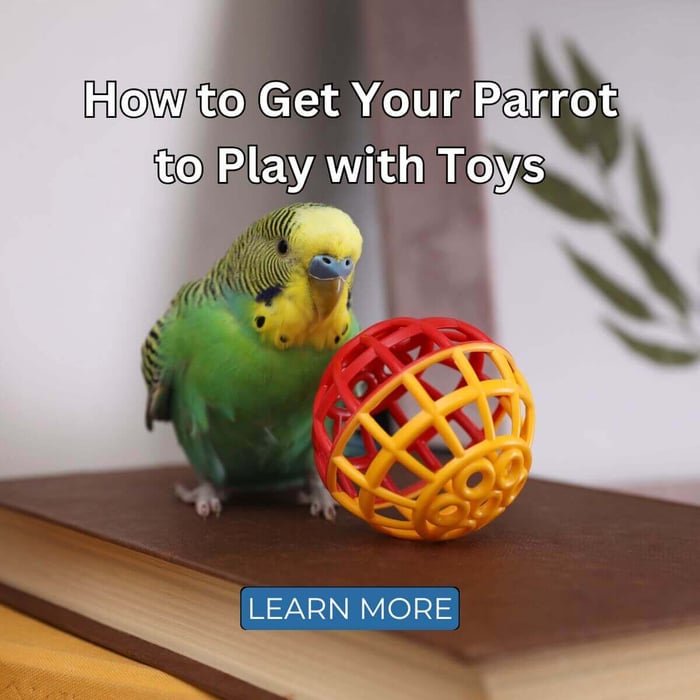How to Teach a Parrot to Step Up
If you've just added a new parrot to your family, it usually won't come with all of the handy behaviours "pre-installed". In fact, it might not even be very tame, especially if it's a pet store or rescue bird! One of the most important tricks you can teach your parrot is to step up. It can come in handy in a range of situations. Let's go into how to teach a parrot to step up. It's easy, and you don't have to be a parrot training expert to do it.
What is Stepping Up?
'Stepping up' refers to when you present a stick or your hand to a parrot or other bird, and it moves onto it. The term comes from the fact that parrots can only really step upwards, not downwards. This means you'll always hold your stick or hand slightly above its feet.
'Stepping down', then, refers to when you set the bird back down to do its own thing. It's a bit of a misnomer because here, too, you'll be presenting the surface at belly level so it can easily be reached.
Why Should You Teach a Parrot to Step Up (and Down)?
The step-up command is one of the first things most parrot owners teach their new birds, and for a good reason. It comes in incredibly useful, and you'll probably end up using it daily, similar to the 'sit' command with a new puppy. Want to get your parrot out of its cage? Step up. Want to get your parrot back in its cage? Step down. Emergency vet visit or evacuation? Step up, and let's go.
Aside from the practical benefits, mastering this command together is also great for you and your bird's bond. It can help a fearful parrot get used to hands and build trust. Once the bird sees that nothing happens when it's on your hand and that you always treat it respectfully, it will be more open to further training.
How to Teach a Parrot to Step Up
There are a few different approaches to how to teach a parrot to step up. Our personal way to go is to use the ever-powerful combination of target and clicker training. Since this is such an incredibly helpful tool in parrot training, we'd like to invite you to find out what it is in the full article on target & clicker training. Before we continue, please begin by using the tips outlined there to target-train your parrot.
Once your parrot has been introduced to the target and has learned to follow it, teaching it to step up is usually a breeze (although some birds are more stubborn than others). For birds that are still very scared of hands or tend to bite, it can help to build an additional layer of trust first. Use a stick instead of your hand or finger for now.
Here's what you'll want to do:
- Prepare for training by picking a quiet but familiar location. Sometimes, on top of the cage works well; other times, it's better to ensure the bird doesn't see its cage.
- Have your clicker, target and training treats ready.
- For scared birds, you'll have to start by getting them to not run away from the stick or hand. Lead them to it with the target. Reward if the parrot gets close to or touches the object, especially with its foot.
- Once your parrot has stopped fearing the hand/stick, present it close to its belly. Aim just above its feet. Don't come so close as to shove or get in the bird's face too much.
- It's a rather natural behaviour for a parrot to step onto any perch-like surface. As soon as it lifts its foot, click and give a reward. If it just steps straight up, that's especially great.
- Now, stop giving a reward for just a touch. Your parrot will have to actually step up now to get its treat. Once it does, click!
- If there is some trust between you guys, it can help to very gently touch your bird's belly. Don't do this if it's still on the apprehensive side.
End the training session after around 15 minutes, even if you haven't managed to make much progress. Some parrots will pick up the concept within a single session, while others need many. Don't try to force it, as you'll just end up making things even more difficult this way.
Please trust us when we say that as long as you're respectful and patient during the process, clicker and target training has almost a 100% success rate for stepping up in the long run. Just make the whole thing a positive experience. Stay open to learning new things about parrot behaviour and your bird's preferences. Also, try reading up on the concept of positive reinforcement for extra guidance!
Tip: Do NOT panic if your parrot uses its beak to help it step up. This is a normal behaviour for them. Unless it's really lunging at you, don't move your hand. If your bird falls because you moved, that will obviously not help your trust levels.
What Next?
Once the parrot has stepped up, begin working on getting it to stay. It has to trust you to set it down again safely, or it will fly away after getting the treat it wants. Keep offering treats, speaking gently and working on being able to move around with your bird on your hand or the stick. Again, this can be more difficult with an apprehensive parrot, but it'll become easier as it begins seeing you more and more as part of its flock. Eventually, it may even fly to you by itself in order to come to hang out.
Teaching the 'step down' command is a lot easier than 'step up'. If you hold your bird at an appropriate height, it will almost always step onto the surface you're offering. The only time it may be less than excited about stepping down is when you're trying to put it back in its cage. That's why we've got an entire post on getting a bird back in its cage that you can check out if need be!
If you taught your bird to step onto a stick rather than your hand, keep using this method until it's fully ingrained in its daily life. Then, you can start repeating the steps above to switch to your hand or finger. You've had some more time to build trust and for the parrot to become desensitised to your scary hands, and you will likely have more success this time around.
Conclusion
Don't underestimate how easy parrots are to train and how useful tricks like stepping up can be in your daily life! Using a target and clicker, you'll have your bird sitting on your finger in no time.
Need some more help in training stepping up? Why not join our Facebook Group?




